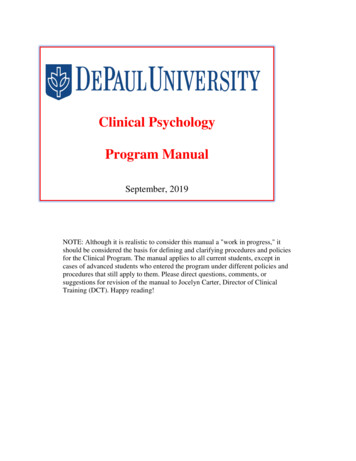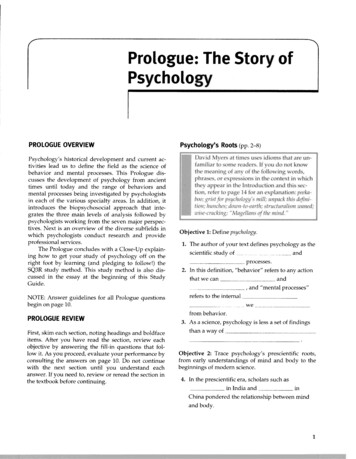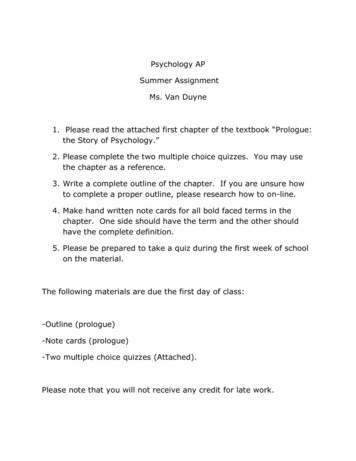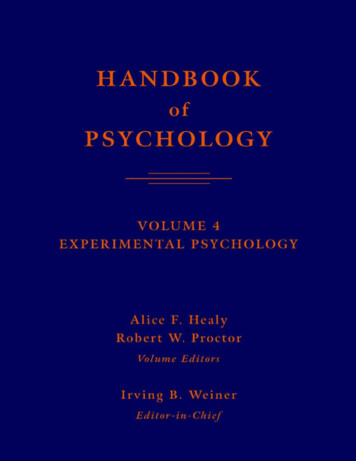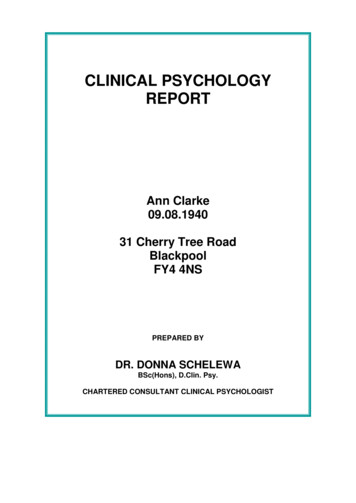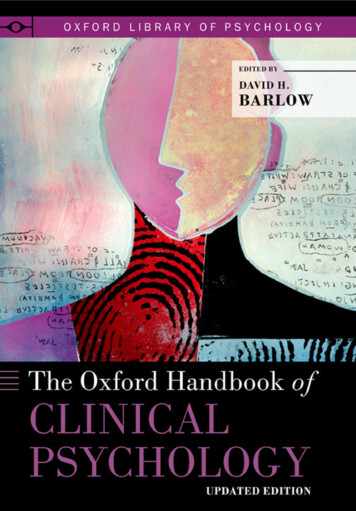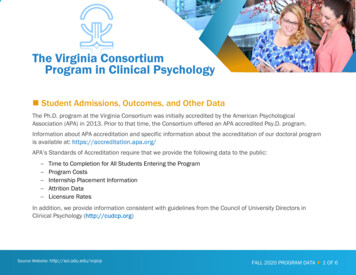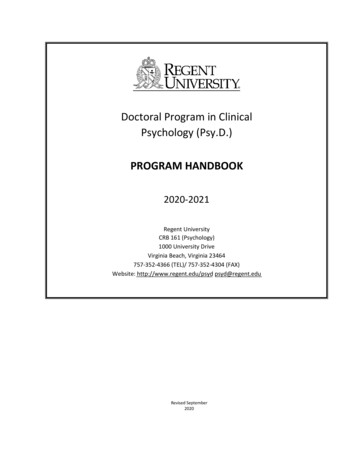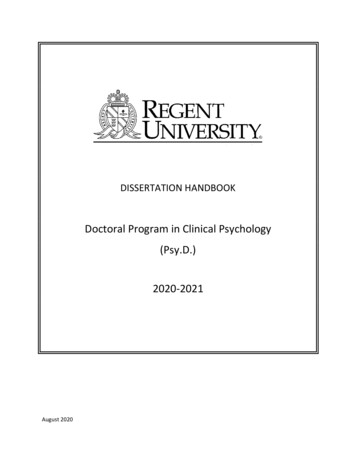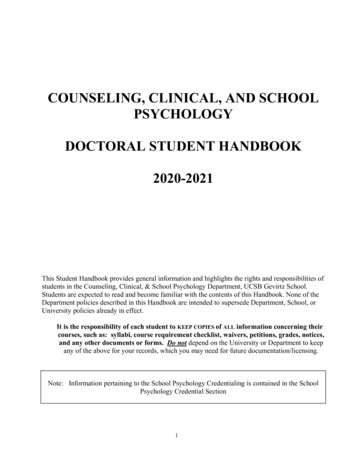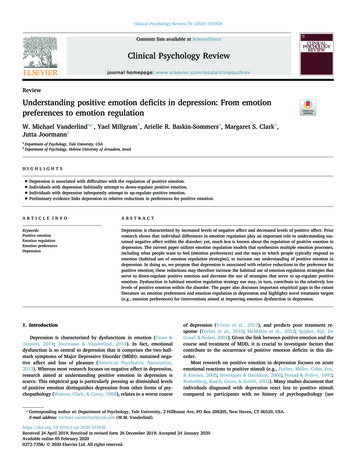
Transcription
Clinical Psychology Review 76 (2020) 101826Contents lists available at ScienceDirectClinical Psychology Reviewjournal homepage: nding positive emotion deficits in depression: From emotionpreferences to emotion regulationT⁎W. Michael Vanderlinda, , Yael Millgramb, Arielle R. Baskin-Sommersa, Margaret S. Clarka,Jutta JoormannaabDepartment of Psychology, Yale University, USADepartment of Psychology, Hebrew University of Jerusalem, IsraelH I GH L IG H T Sis associated with difficulties with the regulation of positive emotion. Depressionwith depression habitually attempt to down-regulate positive emotion. Individualswith depression infrequently attempt to up-regulate positive emotion. Individuals Preliminary evidence links depression to relative reductions in preferences for positive emotion.A R T I C LE I N FOA B S T R A C TKeywords:Positive emotionEmotion regulationEmotion preferencesDepressionDepression is characterized by increased levels of negative affect and decreased levels of positive affect. Priorresearch shows that individual differences in emotion regulation play an important role in understanding sustained negative affect within the disorder; yet, much less is known about the regulation of positive emotion indepression. The current paper utilizes emotion regulation models that synthesizes multiple emotion processes,including what people want to feel (emotion preferences) and the ways in which people typically respond toemotion (habitual use of emotion regulation strategies), to increase our understanding of positive emotion indepression. In doing so, we propose that depression is associated with relative reductions in the preference forpositive emotion; these reductions may therefore increase the habitual use of emotion regulation strategies thatserve to down-regulate positive emotion and decrease the use of strategies that serve to up-regulate positiveemotion. Dysfunction in habitual emotion regulation strategy use may, in turn, contribute to the relatively lowlevels of positive emotion within the disorder. The paper also discusses important empirical gaps in the extantliterature on emotion preferences and emotion regulation in depression and highlights novel treatment targets(e.g., emotion preferences) for interventions aimed at improving emotion dysfunction in depression.1. Introductionof depression (Vrieze et al., 2013), and predicts poor treatment response (Forbes et al., 2010; McMakin et al., 2012; Spijker, Bijl, DeGraaf, & Nolen, 2001). Given the link between positive emotion and thecourse and treatment of MDD, it is crucial to investigate factors thatcontribute to the occurrence of positive emotion deficits in this disorder.Most research on positive emotion in depression focuses on acuteemotional reactions to positive stimuli (e.g., Forbes, Miller, Cohn, Fox,& Kovacs, 2005; Henriques & Davidson, 2000; Persad & Polivy, 1993;Rottenberg, Kasch, Gross, & Gotlib, 2002). Many studies document thatindividuals diagnosed with depression react less to positive stimulicompared to participants with no history of psychopathology (seeDepression is characterized by dysfunctions in emotion (Gross &Jazaieri, 2014; Joormann & Vanderlind, 2014). In fact, emotionaldysfunction is so central to depression that it comprises the two hallmark symptoms of Major Depressive Disorder (MDD): sustained negative affect and loss of pleasure (American Psychiatric Association,2013). Whereas most research focuses on negative affect in depression,research aimed at understanding positive emotion in depression isscarce. This empirical gap is particularly pressing as diminished levelsof positive emotion distinguishes depression from other forms of psychopathology (Watson, Clark, & Carey, 1988), relates to a worse course⁎Corresponding author at: Department of Psychology, Yale University, 2 Hillhouse Ave, PO Box 208205, New Haven, CT 06520, USA.E-mail address: michael.vanderlind@yale.edu (W.M. 826Received 24 April 2019; Received in revised form 26 December 2019; Accepted 24 January 2020Available online 05 February 20200272-7358/ 2020 Elsevier Ltd. All rights reserved.
Clinical Psychology Review 76 (2020) 101826W.M. Vanderlind, et al.Fig. 1. A translation of the instrumental model of emotion regulation (ER) to the study of positive emotion in depression. Within this model, relative reductions inpreference for positive emotion are thought to influence habitual use of positive ER strategies such that individuals with MDD are more likely to engage in strategiesthat serve to avoid or down-regulate positive emotion and less likely to use strategies that serve to up-regulate positive emotion. Habitual ER is thought to affect theexperience of emotion across each stage of emotion generation. The figure synthesizes the extant research that supports each facet of the model.emotions, they do so to achieve a desired emotional end-state (e.g.,Gross, 2015; Mauss & Tamir, 2014; Tamir, 2016). For instance, peoplemight regulate their emotions when they want to increase their level ofhappiness. To attain their emotional preference, people use ER strategies which are likely to yield emotional states that are congruent withtheir emotion preferences (e.g., Millgram, Sheppes, Kalokerinos,Kuppens, & Tamir, 2019). There is empirical work supporting the notion of emotion preferences and its impact on habitual ER. Not only dostudies show that there is variability in emotion preferences (e.g.,Tamir, 2009b; Tamir & Ford, 2009), but they also document that individual differences in emotion preferences influence ER strategy use(e.g., Millgram, Joormann, Huppert, Lampert, & Tamir, 2019;Millgram, Joormann, Huppert, & Tamir, 2015). Among prior work,many researchers utilize instrumental models of ER to understand thenature of negative emotion in depression. To date, however, no reviewhas applied a comprehensive ER model that synthesizes emotion preferences and habitual ER to understand the diminished levels of positiveemotion that characterize depression.The overarching aim of this review is to utilize well-established ERmodels to review the literature on positive ER in depression. Morespecifically, the first aim of the current paper is to use Gross's (1998a)process model of ER as a framework for reviewing difficulties in thehabitual use of positive ER strategies in depression. The second aim ofthe current paper is to adopt instrumental models of ER (Tamir, 2016)that focus on emotion preferences. Then, we will synthesize these ERmodels to review the nature of emotion preferences in depression andthe extent to which emotion preferences might influence the habitualuse of positive ER strategies within the disorder. Better understandingof the nature of positive ER in depression and factors that contribute tohabitual ER holds great promise for the refinement of treatments aimedat improving positive affect deficits in depression.Bylsma, Morris, & Rottenberg, 2008, for a meta-analysis). Findingsshowing depression-related reductions in emotional reactivity to positive stimuli span multiple levels of analysis, including self-reports ofemotion (Sigmon & Nelson-Gray, 1992), behavioral expressions ofemotion (Rottenberg et al., 2002; Sloan, Strauss, Quirk, & Sajatovic,1997), psychophysiological responding to positive stimuli (Dichter,Tomarken, Shelton, & Sutton, 2004; Rottenberg, Gross, & Gotlib, 2005),and brain activation during exposure to positive material (see Admon &Pizzagalli, 2015, for a review). When examining emotion, however,researchers not only look at initial reactivity to positive stimuli but alsoat how individuals respond to and regulate emotion (Hare et al., 2008;Domes et al., 2010; Heller et al., 2009; Carthy, Horesh, Apter, Edge, &Gross, 2010; Silvers et al., 2012; Rottenberg, 2017).Emotion regulation (ER) refers to processes that modify the frequency, intensity, and duration of emotional states (Gross, 2014; Gross,2015). Although most research focuses on the regulation of negativeaffect, studies show that people also regulate positive emotion(Feldman, Joormann, & Johnson, 2008; Tugade & Fredrickson, 2007;Werner-Seidler, Banks, Dunn, & Moulds, 2013). Difficulties in ER areimplicated in many forms of psychopathology (see Aldao, NolenHoeksema, & Schweizer, 2010, for a meta-analysis). With regard todepression, an abundance of research shows that ER difficulties play acentral role in understanding sustained negative affect in depression(Joormann & Stanton, 2016; Joormann & Vanderlind, 2014; Liu &Thompson, 2017). However, there is only a limited amount of researchon the regulation of positive emotion in the disorder.Most research on ER focuses on the strategies people use to regulatetheir emotions (Gross, 1998a; Gross, 2015). As seen in Gross's (1998a)process model of emotion regulation, ER strategies include cognitiveand behavioral processes that modify emotional experiences. In a recentreview, Liu and Thompson (2017) note that the most common type ofER difficulty in depression involves problems with the habitual use ofER strategies. The habitual use of ER strategies refers to the frequencywith which a strategy is utilized over time (Gross, 2014). Dysfunction inhabitual ER arises when individuals frequently engage in responsestyles that exacerbate emotional problems and infrequently use strategies that serve to ameliorate affective dysfunction (Joormann &Stanton, 2016; Liu & Thompson, 2017).Recent expansions of the process model, however, focus on thequestion of why people have preference for certain ER strategies overothers. Instrumental models of ER (Tamir, 2009a; Tamir, 2016), forexample, highlight the concept of emotion preferences, defined as desired emotional states (Tamir, 2009a). When people regulate their2. Habitual use of positive ER strategies in depressionGross's process model (1998a) proposes that ER strategies can occuracross a set of stages that are thought to underlie the generation of anemotional experience (see Fig. 1). Specifically, this model catalogs ERstrategies across four stages of emotion generation. The first stage is theoccurrence of an emotion-eliciting situation. Attention is then directedtowards the situation (stage 2), and, subsequently, an interpretationregarding the meaning of the event is made (stage 3). This cascade ofprocesses is thought to, in turn, generate a particular emotional response (stage 4).2
Clinical Psychology Review 76 (2020) 101826W.M. Vanderlind, et al.to all word types equally. Similar findings also have been observedamong individuals diagnosed with MDD (Gotlib et al., 1988; Joormann& Gotlib, 2007; McCabe & Gotlib, 1995) and in samples of individualswith remitted depression (Joormann & Gotlib, 2007). Additionally,some researchers reported that depressed participants avoid attendingto positive stimuli. For instance, Shane and Peterson (2007) presentedindividuals with positive-neutral word pairs and found that individualswith elevated depressive symptoms were more likely to attend toneutral information over positive information; the opposite pattern wasseen among individuals with low levels of depressive symptoms. Thus,in this study, participants with elevated depressive symptoms fail toexhibit a bias towards positive over neutral information and they selectively avoided attending to positive stimuli and attended to neutralinformation instead. Consistent with the Shane and Peterson (2007)study, avoidance of positive stimuli was observed in youth diagnosedwith clinical depression (Hankin, Gibb, Abela, & Flory, 2010). Of note,other studies failed to demonstrate positive attention biases betweendiagnostic groups (e.g., Mogg, Bradley, & Williams, 1995; Mogg,Bradley, Williams, & Mathews, 1993; Mogg, Millar, & Bradley, 2000;Sanchez, Vazquez, Marker, LeMoult, & Joormann, 2013). However,some of these studies focused on the subliminal processing of emotionalinformation. In general, findings in the extant literature were moreconsistent when researchers examined attention over longer periods oftime (i.e., at least 1000 milliseconds).Regardless of biases in attention (i.e., selectively attending to certain types of information over others), some researchers have foundthat diagnostic groups differ in regard to the amount of time spent attending to positive stimuli. When presented with a 2 2 array ofemotional (sad, threat, positive) and neutral words, individuals diagnosed with MDD (Kellough, Beevers, Ellis, & Wells, 2008) and participants with elevated symptoms (Sears, Newman, Ference, & Thomas,2011) spent less time looking at positive information than healthycontrols and individuals with low levels of depressive symptoms, respectively. Duque and Vázquez (2015) reported comparable findingsusing paradigms comprised of positive-neutral image pairs. Taken together, these studies show that individuals with depression lack a positive attentional bias and attend to positive stimuli less than healthycontrols. Thus, at the level of attention allocation, reduced selectiveattention to positive stimuli may contribute to low levels of positiveemotion among individuals with depression compared to healthy controls.The categories of ER strategies correspond to these four stages ofemotion generation. At stage 1 (occurrence of emotion-eliciting situation), situation selection can be used to avoid or to enter into the situation. At the second stage (attention to emotional stimuli), attentioncan be allocated away from emotion-eliciting stimuli to decreaseemotion or allocated towards emotion-eliciting stimuli to increaseemotion. The third stage of emotion generation is interpretation. Manyemotion-eliciting situations are ambiguous, and the way in which asituation is interpreted or appraised, whether automatic or deliberate,may alter emotional experiences. The regulatory strategy that occurswithin stage 3 is reappraisal. Reappraisal is an ER strategy wherebypeople change their initial interpretation of a situation to modulateemotional responding (Gross & John, 2003). For instance, interpretingone's failure to say “hello” as a simple oversight rather than a deliberateact of avoidance is likely to elicit lower levels of negative emotion.Finally, ER strategies that occur at the fourth stage of emotion generation (emotion elicitation) are referred to as response-focused ERstrategies, as they are thought to occur in response to the emotion thathas been evoked (Gross, 1998a). There are a number of response-focused ER strategies, and these strategies modulate emotion in differentways (Aldao et al., 2010; Gross, 2014). For instance, some peoplesuppress the behavioral expression of emotion whereas others elaborateon the causes and consequences of the emotion. Whereas most existingresearch focuses on the regulation of negative affect, this review willfocus on ER strategies known to modulate positive emotion and on thehabitual use of positive ER strategies in depression.2.1. Situation selectionAs noted by Liu and Thompson (2017), few studies have examinedsituation selection in depression, particularly as it pertains to positivestimuli. Some notable exceptions found that depression is related to lessexposure to events that are likely to elicit positive emotion. Lewsinsohnand Libet (1972), for example, reported that depressive symptoms wereinversely associated with the frequency of engaging in self-reportedpleasurable activities. In more recent work, MDD participants weremore likely to choose exposure to sad over happy music compared tocontrol participants, who were more likely to choose exposure to happyover sad music (Millgram et al., 2015). In a separate sample, however,the authors showed participants positive, negative, and neutral images,and participants were given the option to view each image for a secondtime or to view a blank computer screen before the start of the nexttrial. The authors found that individuals with MDD were more likely tochoose to view sad images over a blank computer screen compared tohealthy controls; however, both groups chose positive images andneutral images over a computer blank screen to a similar degree. Although more research is needed in this area, the few existing studies onsituation selection suggest that depression is associated with reducedselection of positive situations, particularly when choosing betweenpositive and negative stimuli.2.3. Interpretation and reappraisalCognitive models of depression highlight the tendency to makemore negative and less positive appraisals of emotion-eliciting events asa central feature of depression (Mathews & MacLeod, 2005; Teasdale,1988). Supporting this notion, multiple studies found that individualswith depression display biases in their interpretations of ambiguousevents. Researchers have previously assessed interpretation biases byrecording appraisals during exposure to ambiguous events (e.g.,scrambled sentences, homophones, fictional scenarios) that can eitherbe interpreted as positive or negative. For example, Rude, Wenzlaff,Gibbs, Vane, and Whitney (2002) presented participants with scrambled sentences comprised of six words. The participants were asked toselect five of the six words and arrange the words to create a logicalsentence. The sentences could either be unscrambled to create positiveor negative sentences, and the authors found that greater propensity tounscramble words to form negative over positive sentences was associated with increases in depressive symptoms (Rude et al., 2002) andwith a subsequent diagnosis of MDD (Rude, Durham-Fowler, Baum,Rooney, & Maestas, 2010) at a follow-up assessment. Relatedly, researchers found that individuals with depression are more likely tointerpret ambiguous stimuli as negative instead of positive (CowdenHindash & Amir, 2012; Everaert, Bronstein, Cannon, & Joormann,2018; Orchard, Pass, & Reynolds, 2016). A proclivity to make more2.2. Attention allocationMany researchers have found that individuals with no history ofpsychopathology exhibit an attentional bias towards positive stimuli(Ellis, Beevers, & Wells, 2011; Gotlib, McLachlan, & Katz, 1988;Joormann & Gotlib, 2007; McCabe & Gotlib, 1995). That is, in thesestudies, healthy controls were more likely to selectively attend to positive stimuli over neutral and/or negative stimuli. In contrast, multiplestudies have reported that individuals with elevated depressive symptoms lack a positive attentional bias. For example, Ellis et al. (2011)presented participants with a 2 2 assortment of emotional (positive,dysphoric, aversive) and neutral words and tracked their eye gaze overtime. Whereas individuals with low levels of depressive symptoms spentmore time attending to positive words than neutral, aversive, or dysphoric words, individuals with elevated depressive symptoms attended3
Clinical Psychology Review 76 (2020) 101826W.M. Vanderlind, et al.of emotionally-ambiguous events and are less likely to use reappraisalto override initial (presumably negative) interpretations. The tendencyto make negative over positive interpretations and the infrequent use ofreappraisal to override this tendency is thought to set the stage forelaborated processing of negative material. According to the processmodel (Gross, 1998a), elaboration on negative appraisals is, in turn,likely to yield negative emotion instead of positive emotion.negative interpretations and less positive interpretations of ambiguousinformation also was observed among healthy youth at risk for depression via their mother's psychiatric history (Dearing & Gotlib, 2009).Further, researchers documented a link between the degree to whichindividuals make negative over positive interpretations and depressionseverity (Lee, Mathews, Shergill, & Yiend, 2016).Recent research further characterized depression-related difficultiesregarding interpretation. Specifically, Everaert et al. (2018) had participants complete an interpretation flexibility task to measure the degreeto which pe
Apr 24, 2019 · a Department of Psychology, Yale University, USA b Department of Psychology, Hebrew University of Jerusalem, Israel .

